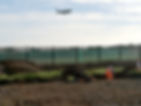A ‘Short’ history of Rochester Airport
- admin76749
- Oct 12, 2022
- 2 min read

In September 1933, the Rochester Corporation acquired over 100 acres of farmland as the site for a municipal airport. The first flight into Rochester was from Gravesend, and civilian services began after that, in June 1934, with flights to Southend Airport. A return trip would set you back 12 shillings, or 60p in modern money!

In 1934–5, aircraft manufacturers the Short Brothers Ltd took over the airport and made Rochester its main base. Shorts, as it was also known, was founded in 1908 in London and had been working at Eastchurch on Sheppey since c 1910. Prior to the move to the airport, they had been building sea-planes on the Rochester Esplanade. It was the first company in the world to make production aeroplanes and wanted to expand from making sea-planes to standard aircraft.
In 1936, Short Bros designed and built a heavy bomber prototype, which later led to the development of the first four-engine bomber to serve in the Royal Air Force, the Short S.29 Stirling.
Rochester airport was heavily bombed by the Luftwaffe on 15 August 1940. The factory, the runway and other buildings were hit. Five Stirlings were destroyed, and a member of the fire service lost his life. The airfield was returned to civilian use at the end of the Second World War.


As a result of the wartime bombing, the initial phase of works at #InnovationParkMedway involved investigations to determine the potential for unexploded ordnance (UXO). In September 2021, a magnetometry survey of the site was conducted which detected a total of 361 anomalies potentially indicating the presence of UXO, some of which were investigated further. This yielded a range of metal objects including plough shares, metal cans and hand tools. Fragments of decommissioned pipe-bombs were also recovered, and some bomb craters were identified. One very surprising find was a Kinder egg toy (one of the Magic Sport collection, issued 2005), which let off a very high magnetic signal!

Certainly, one of the more unusual things about working on this site was the fact we were working alongside an airport with a busy little runway. All sorts of light aircraft, including the Air Ambulance would land and take-off and it provided an interesting backdrop to our work.
Frances Morgan, Senior Archaeologist





